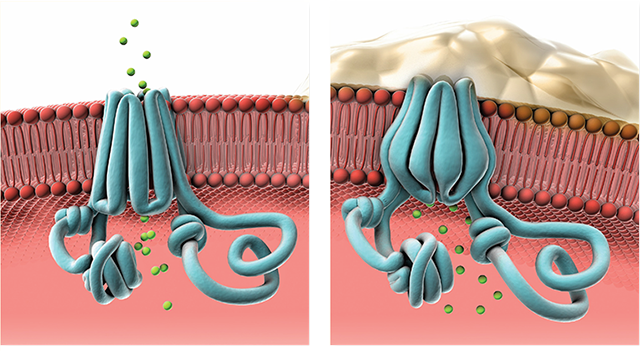CHAPTER 4 Reference Readings
Lesson 2
Why is high cholesterol an indicator of heart disease?
What is cholesterol and where does it come from?
Cholesterol belongs to the category of biological molecules called lipids. Lipids are a diverse group that includes fats, waxes, and steroids. One property all lipids have in common is that they do not dissolve easily in water. While all living things have lipids, cholesterol is found only in animal cells. Cholesterol is not found in plant, fungal, or bacterial cells.
The body has two sources of cholesterol. It can come from cholesterol in our diets. When we eat animal products, we ingest the cholesterol from those animals. All meats, including fish, have cholesterol. Dairy products such as milk, eggs, and cheese also have cholesterol because they are from animals. Fruits and vegetables do not have cholesterol. Foods that come from plants, such as beans or tofu, do not have cholesterol. The body can also make its own cholesterol in the liver. In fact, our bodies are capable of making all the cholesterol we need, so we do not need to get it in our diets.
What does cholesterol do in the body?
The structure of a molecule determines its function. In humans and other animals, cholesterol is an important component of cell membranes. It is smaller than phospholipids, which form the two layers of the membrane. When cholesterol molecules insert among the “tails” of the phospholipids they help form the barrier that prevents unwanted molecules from crossing into or out of the cell. They also help regulate the fluidity of the membrane and keep it from being too rigid or too loose.
Animal cell membrane. Cholesterol molecules are embedded between phospholipids in the cell membrane and affect membrane permeability and fluidity.
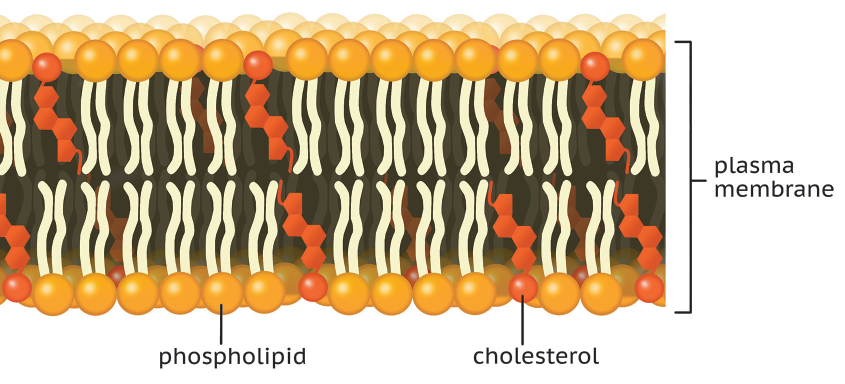
Cholesterol also has functions outside the cell membrane. It is the molecule the body starts with to make important hormones like testosterone and cortisol, a stress hormone. The liver also uses some cholesterol to help make bile salts. Bile helps in the digestion of fats.
How does cholesterol move through the body?
The bloodstream delivers cholesterol to cells throughout the body. In addition to red and white blood cells, blood contains a variety of substances dissolved in the watery part of the blood, called plasma. As a lipid, however, cholesterol does not dissolve in water. So how does cholesterol move around the body?
Cholesterol is transported in the blood plasma to cells in particles called low-density lipoproteins, or LDLs. These particles contain cholesterol and other fat molecules surrounded by a single layer of phospholipids. The “heads’’ of the phospholipids attract water and make it possible for LDLs to move easily with the other substances in the bloodstream.
Cholesterol can be transported from cells to the liver for removal. This cholesterol moves in the bloodstream inside particles similar to LDLs, but the particles are smaller. They contain fewer cholesterol molecules and more proteins in the phospholipid layer of the particle. These particles are called high-density lipoproteins, or HDLs.
Cholesterol movement in the body. Cholesterol molecules (yellow) do not dissolve in water but can be transported through the blood in particles called LDLs and HDLs.
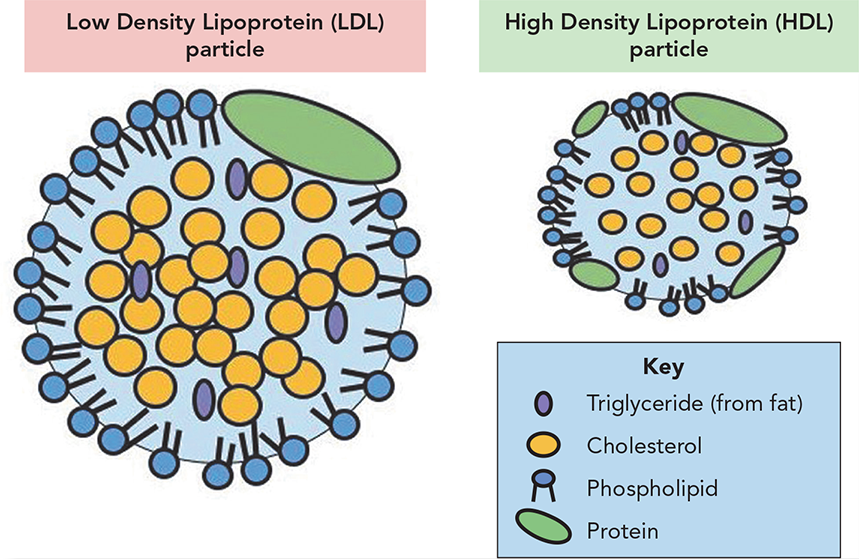
How does the body maintain healthy levels of LDL in the blood?
In unit 1, we learned that a healthy body maintains many characteristics within a fairly narrow range. A healthy body temperature is between 96°F (35.6°C) and 99°F (37.2°C). Healthy blood sugar levels range from 70 mg/dL before eating to 140 mg/dL 2 hours after eating. Similarly, the body regulates the amount of cholesterol that it makes.
A blood test that measures cholesterol levels is called a Lipid Panel Test. It measures LDL as well as high-density lipoprotein (HDL), total cholesterol, and fats called triglycerides. Healthy adults have an LDL level of 100 mg/dL or less. Children and teens should have 110 mg/dL or less. Unhealthy LDL levels are above 160 mg/dL for adults or above 130 mg/dL for children and teens.
If there is only a little bit of cholesterol in a person’s diet, the liver increases its production of cholesterol. On the other hand, if there is a lot of cholesterol in the diet, the liver decreases its production of cholesterol. The liver can also decrease blood cholesterol levels by taking in HDLs and disposing of the cholesterol. Unhealthy levels of HDL call for actions to reduce those levels to decrease the chance of developing heart disease.
Cholesterol levels in a small sample of people. Each dot represents a patient’s LDL cholesterol level as measured by a standard blood test. Shaded areas indicate a range that is considered high cholesterol by medical professionals.
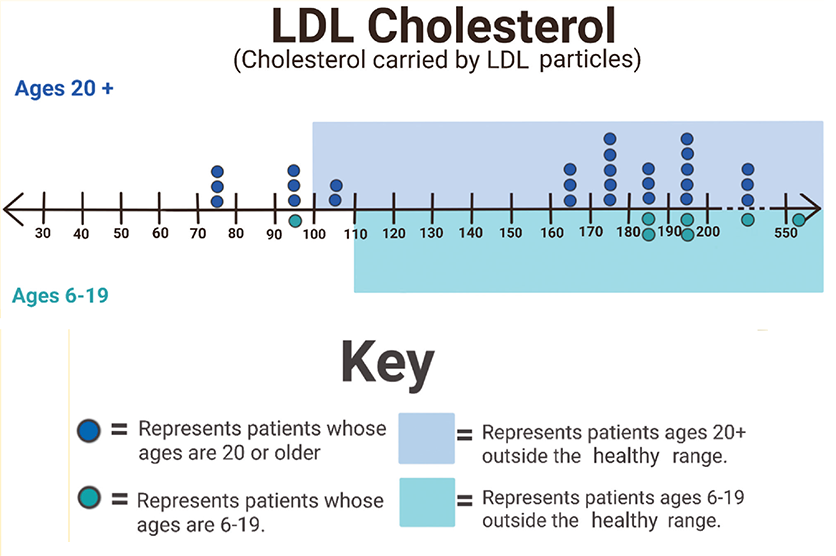
How do high LDL levels affect the heart?
High LDL levels mean that there are many of the LDL particles moving through the body in the bloodstream. The body’s cells will only take in so much for cholesterol for cell functions or disposal. The excess LDLs get deposited in the arteries. If LDL levels remain high for a long time, the extra particles accumulate and form thick areas called plaques.
Plaques also build up at places where there is damage in a blood vessel. Damage may come from high blood pressure, smoking, diabetes, or other causes. When the immune system works to repair the walls of the blood vessel, LDLs and other particles can get trapped in the walls.
Over time plaques grow thicker and cause the arteries to narrow and harden. Sometimes a plaque can rupture and start an immune response forming a clot that blocks blood flow. Heart disease occurs when the plaques build up to a level that affects the transport of oxygen and nutrients to the heart muscle. This is similar to traffic jams we experience on highways when there is a change from two lanes to only one.
The narrowing of coronary arteries (the blood vessels that supply blood to your heart) is a dangerous condition. If blood flow to the heart decreases, the lack of oxygen causes some heart muscle cells to die. This causes chest pain. If the plaques build up enough that blood flow is completely blocked, the blockage and cell death cause a heart attack.
Two views of a partially blocked artery. A. A cross section of a blood vessel with plaque (yellow blob in top right) B. Side view of an artery that has a large plaque, shown in yellowish white. Plaques affect the blood flow in the artery.
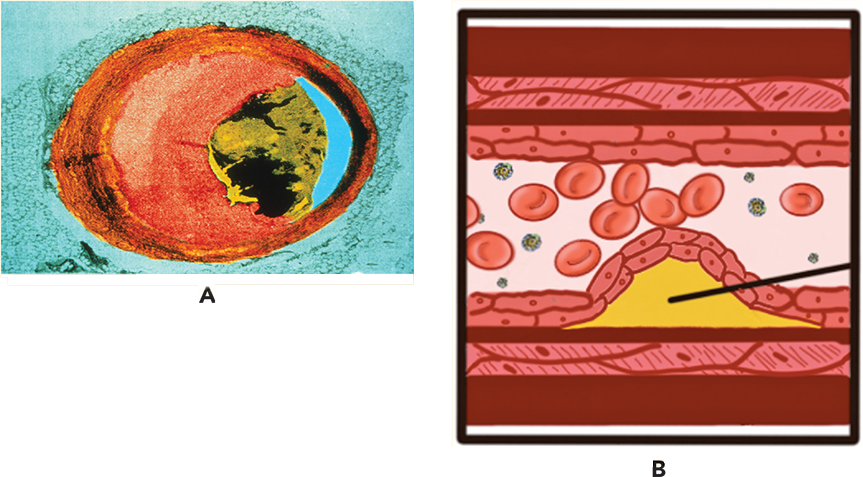
Lesson 3
What could cause someone’s cholesterol to be high?
How does the body regulate LDL levels in the blood?
LDL particles enter the bloodstream following the digestion of food that contains cholesterol or when the liver produces and releases it. LDL particles are taken out of the bloodstream when they move into cells throughout the body. Cells regulate, or control, how much cholesterol they take in. You may already know that the cell membrane serves an important function by being “selective” about what is allowed to go into or out of cells. Typically, large particles are prevented from crossing the membrane.
LDL particles have a structure on their surface that is analogous to a key. It is a protein that can help “unlock” an entry point that brings LDLs into a cell. This protein is called Apo-B. The entry point on the cell membrane is also a protein, called the LDL receptor. There are many different proteins in our bodies and they perform many different and important functions. In this case, if both proteins function correctly a cell absorbs LDLs. This decreases the level of cholesterol in the bloodstream.
After delivering the LDL particle into the cell, the process repeats. LDL receptors are recycled to the cell membrane where they attach to and bring more LDL particles into the cell. The cellular level of cholesterol continues to increase and the blood level of LDL continues to decrease. Over time the cell may accumulate more cholesterol than it needs.
LDL processing. a. The attachment of an LDL particle to an LDL receptor on the cell membrane is the first step in moving cholesterol from the bloodstream into cells. b. After the receptor attaches to the particle it draws the LDL into the cell.
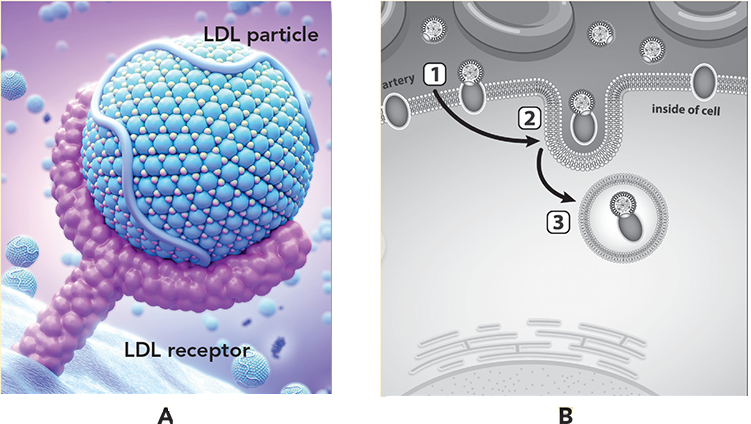
The body makes another protein that helps keep levels of cholesterol within healthy ranges. This protein is called PCSK9. It regulates cholesterol accumulation. When it attaches to an LDL receptor, after the receptor goes into the cell, the receptor gets broken down, rather than sent back to the membrane and reused. With fewer receptors recycled to the cell membrane, fewer LDL particles are brought into the cell. The level of cholesterol in the cell decreases while the level of LDL in the blood increases. Increasing or decreasing the number of receptors on cells is a key part of cholesterol homeostasis.
PCSK9 regulation of LDL receptor function. The blue molecules attached to the stem of the LDL receptor are PCSK9 proteins. They prevent the recycling of the receptors.
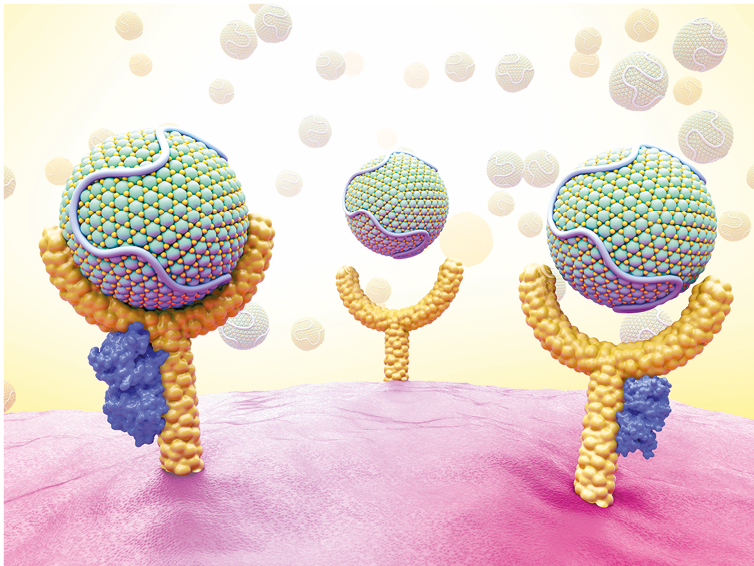
What gives proteins like the LDL receptor their shape?
You can see from the examples we have examined that the function of proteins requires the ability to attach to other molecules. In order to do this, they must have the right shape to fit together. But how is the shape of proteins determined?
Proteins are large molecules built from subunits called amino acids. When cells make proteins, many amino acids are bonded together to form a long chain. The chain then folds into a three-dimensional shape. The shape is very important to the function the protein carries out.
Proteins range in size from a few hundred amino acids to more than 30,000 amino acids. However, there are only 20 different amino acids found in proteins. What makes one protein different from others is the sequence, or order, of the amino acids.
Amino acids have characteristics such as having a positive charge or being attracted to water. When a chain of amino acids folds, there are chemical interactions between the amino acids. For example, two amino acids might have a relatively strong attraction, a weak attraction, or may even repel one another if they are close together. Within a protein there are hundreds of interactions and the end result is the formation of the protein’s unique shape.
Differences in amino acid sequences cause the different shapes for the LDL receptor, Apo-B, and PCSK9 proteins. This cause-and-effect relationship is true for all of the body’s proteins and leads to the diversity in structure and function in this class of biological molecules.
Models can help us visualize proteins. Computer models can help us visualize the detailed molecular structure while simpler models can help us test ideas about changing amino acids and the resulting effects on shape.
Amino acids and proteins. Proteins are complex molecules made from bonding many amino acids into a long chain. The sequence of amino acids results in the folding of a protein into its functional form.
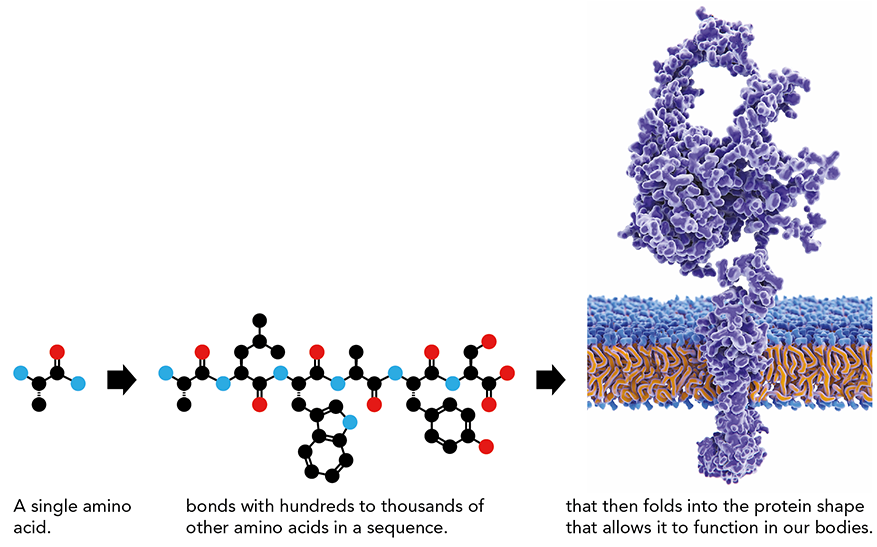
How do changes in the LDL receptor protein affect LDL levels in the blood?
Some people who have high levels of LDL in their blood have changes in the LDL receptor protein. If the amino acid sequence of a protein is changed, it often changes the shape of the protein. This change may affect its function. If a change in one or more amino acids in the LDL receptor protein changes the shape of its binding region, it may not be able to attach to LDL particles. Then, it will not function correctly to bring LDL particles into the cell.
In other cases, there is a change in the amino acids in the stem region of the LDL receptor. For people who have this change, the receptor can still attach to the LDL particle, but it is unable to draw it into the cell. When the LDL receptor function is affected, LDL particles remain in the blood, which explains why these individuals have high LDL.
What are other examples of diseases caused by changed protein structures?
Another example of the effect of a change in a protein is the disease cystic fibrosis. In this case, there is a change in a cell membrane protein that is important for regulating the movement of salt in and out of cells. As a result, people with cystic fibrosis produce thick, sticky mucus that clogs a variety of ducts and passageways in the body. Because the lungs become clogged with this thick mucus, people who have cystic fibrosis are especially likely to develop lung infections and pneumonia. They also have digestive problems because the thick mucus prevents digestive enzymes from moving easily into the intestines.
Scientists have discovered that many human diseases are caused by changes in protein function, due to changes in amino acid sequences.
Healthy and abnormal membrane protein in cystic fibrosis. The healthy membrane protein, shown on the left, allows salts (green) to pass through the cell membrane. People who have cystic fibrosis have a membrane protein with a different shape, shown on the right. This protein does not allow salts to pass through the membrane and mucus (beige) builds up outside the cell.

Lesson 4
Chromosomes, genes, and proteins
Where does the LDL receptor protein come from?
Proteins perform a variety of critical functions in the body. Many are enzymes, which enable specific and important chemical reactions to occur. Others form important structures such as the keratin in hair and fingernails. Collagen is the most abundant protein in the body, found in skin, tendons, cartilage, and other connective tissues. Some proteins are chemical messengers, like insulin, which helps regulate glucose (sugar) levels in the blood. Antibodies produced by immune system cells are also proteins. How does the body produce so many different proteins? What information is in cells to produce these molecules when they are needed?
Remember that proteins are built from amino acids that are linked together. Each type of protein has its own unique sequence of amino acids. If a cell needs to produce more LDL receptors, it needs to first construct the correct chain of amino acids. But where—and what—are the instructions for producing proteins? The short answer to this question is genetic information.
For all life on Earth, genetic information is stored in molecules called DNA. Some living things, like bacteria, have a single molecule of DNA or one chromosome. Most living things have two or more molecules of DNA. Humans cells have 46 DNA molecules, organized as 46 chromosomes. There are more than 20,000 genes in our DNA! No wonder we can produce so many different proteins.
Knowing some terms that describe the organization of genetic information can help a lot in understanding protein production in cells.
DNA stores and transmits information for making proteins. A section of a DNA molecule contains the information for a sequence of amino acids, which makes the protein.
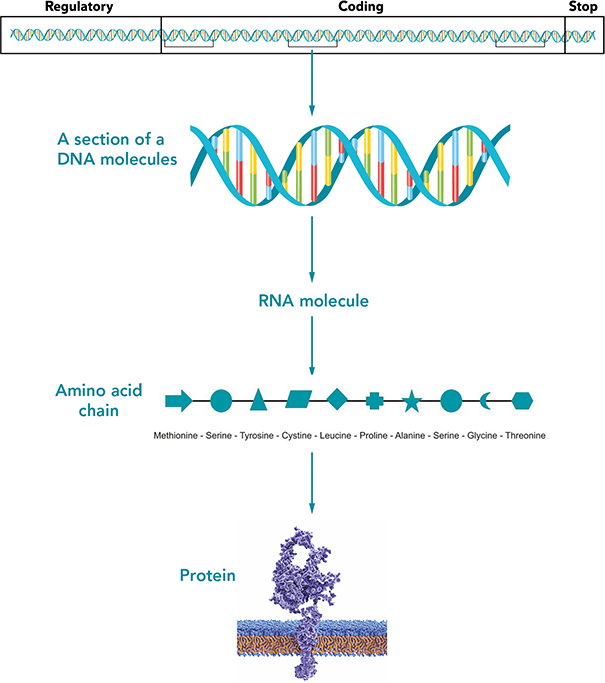
What is the relationship between DNA, chromosomes, and genes?
You are likely familiar with the double-helix shape of DNA. If we look for DNA in a cell with a microscope we will find it in the cell nucleus in structures called chromosomes. Chromosomes are made of one very long DNA molecule wrapped around a variety of proteins and then coiled up.
Genes are regions within the DNA molecule—each human chromosome has many genes. The LDL receptor gene (LDLR) is located on chromosome 19. This chromosome has approximately 1,500 different genes that provide instructions for making more than 1,500 unique proteins, including the LDL receptor.
Chromosome structure and genes. a. A molecule of DNA coiled around proteins is a chromosome. Each chromosome contains many genes, which are sections of DNA. b. Each gene has a specific place on the chromosome. DNA is made up of small subunits abbreviated as G, C, A, and T.
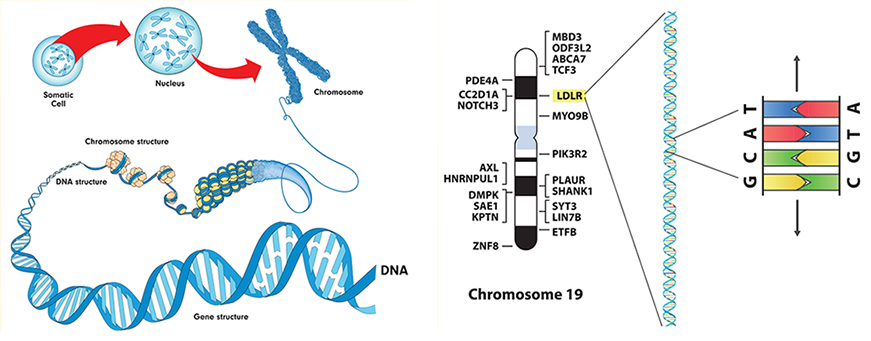
What is the connection between genes and proteins?
To understand how genetic information in DNA leads to the formation of a functional, specialized protein we need to look more closely at how DNA is organized.
The subunits for DNA are molecules called nucleotides. DNA has four different types of nucleotides named adenine, guanine, cytosine, and thymine, which are abbreviated A, G, C, and T. A strand of DNA has a specific sequence of nucleotides. Two nucleotide strands twist around each other and are held together by weak bonds between the nucleotides in a DNA molecule. This forms a shape that is often referred to as a double helix. Even though the bonds between a pair of nucleotides are weak, there are so many of them in DNA that the molecule is very stable.
Illustrations of DNA, like in the figure above, only show a part of a gene and not the whole gene, which would be many thousands of base pairs long. The nucleotide sequence of a gene is the instructions that guide the sequence of amino acids for the protein determined by the gene. Notice that we have now discussed how the sequence of subunits is important for the function of two different kinds of biological molecules, DNA and protein:
Biological molecule |
Structure |
Function |
|---|---|---|
DNA |
Sequence of nucleotides: A, G, C, T |
Instructions for sequence of amino acids in proteins |
Protein |
Sequence of amino acids: alanine, serine, valine, etc. |
Folding pattern of protein needed for it to do its job |
The next section describes how the gene’s instructions work.
How does the LDL receptor gene guide the production of LDL receptor proteins?
The LDLR gene has a sequence of nucleotides that are the instructions for putting the amino acids of the LDL receptor protein together in the right sequence so that it can attach to LDL particles and bring them into the cell. Understanding how this protein-building process happens can help us understand how amino acids changes might happen.
The first step in using the information in the LDL receptor gene is to construct another biological molecule that is very similar to DNA. This molecule is called RNA. You may have noticed this molecule in one of the images presented earlier. RNA is a “messenger” between the DNA, which stays in the nucleus, and the final protein product of the gene.
Every three nucleotides codes for one amino acid. So, building a protein essentially consists of decoding 3-letter sequences to construct a chain with the correct order of amino acids. In the figure below, two codes in the gene sequence are GGG and CCC. Using the chart to decode these, the two amino acids added to the chain would be Glycine and Proline.
Even as the protein is being made in the cytoplasm, it will begin folding up based on its amino acid sequence. As we have seen in the case of the LDL receptor protein, the shape of the final, folded protein is critical for it to function correctly.
glycine - proline - tryptophan - glycine - tryptophan - lysine - leucine - arginine
Translation. A sequence of nucleotides determines the order of amino acids in the protein. Each set of 3 nucleotides codes for one amino acid, or acts as a stop signal to end the process.
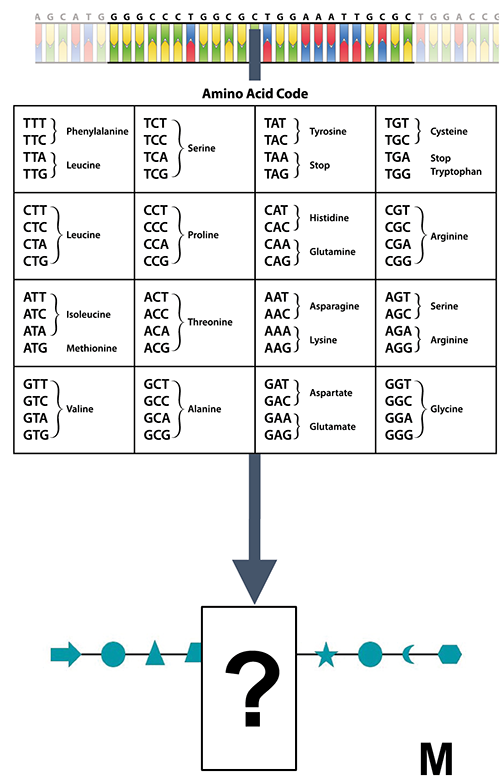
Gene regulation. The regulatory region has information that tells the cell things like when to make the protein and how much protein to make. The stop region has information that tells the cell where the end of the gene is.

Regulation is important to living things at many scales. Not only do humans regulate cholesterol through cell processes, they also regulate their genes. You may recall from unit 1 that cell activities require energy. Therefore, cells only make certain proteins and only at certain times. Some sections of DNA play a role in determining when certain proteins are produced and in which cells.
What is the relationship between the LDL receptor gene and different LDL receptor proteins?
In the previous lesson, we learned that some people who have high levels of cholesterol in their blood have changes in the amino acid sequence of their LDL receptor proteins. In this lesson we learned that the amino acid sequence in a protein is determined by the nucleotide sequence in the gene in DNA. Thus, changes in the amino acid sequence of LDL receptor proteins are due to changes in the nucleotide sequence in their LDL receptor gene on chromosome 19.
Humans have two copies of each gene, one copy of each on the chromosomes inherited from each parent. The two copies of each gene may have identical nucleotide sequences, or they may have sequences that differ in one or more nucleotides. These differences create different versions of a gene. The different versions are called alleles. An individual may have two identical alleles of a gene, or two different alleles of a gene.
Alleles. Sequence 1 is a portion of the LDLR gene on the chromosome inherited from one parent and sequence 2 is part of the gene copy on the chromosome inherited from the other parent.
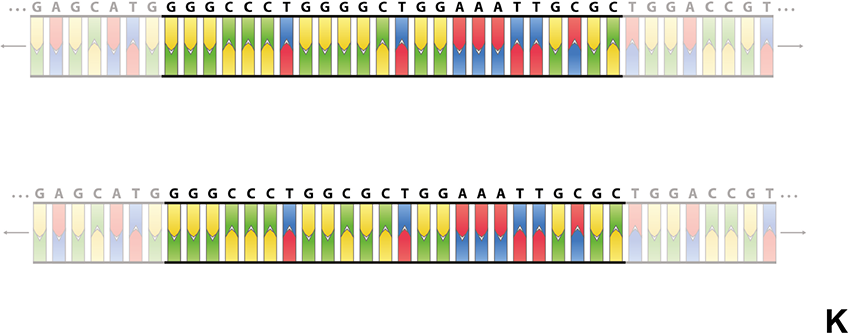
Different versions of a gene, or alleles, initially arise in a population through mutation. Once a change occurs in the DNA, it can continue to be inherited in future generations. A difference or change in the DNA nucleotide sequence of a gene is called a mutation.
More than 2,000 different alleles of the LDL receptor gene have been found. In some cases, the mutations do not affect the amino acids in the LDL receptor protein, so it is not changed. In other cases, the mutations do result in a change in an amino acid in the protein, but this change does not affect its folding pattern, so it still works correctly. Unfortunately, some mutations result not only in a change in an amino acid but also in a change in the folding pattern so that the LDL receptor protein is defective. Some mutations in the gene even cause the protein not to be made at all. Different cause-and-effect relationships between mutations in the LDLR gene and the shape and function of the LDL receptor protein are described in the chart below.
Class of allele |
Result for LDL receptor protein |
|---|---|
1 |
Mutation prevents receptor from being made. |
2 |
Mutation causes shorter protein that does not function. |
3 |
Mutation causes change in the receptor binding area so it cannot attach to LDL particle. |
4 |
Mutation causes change at the end of the protein so it cannot pull the LDL particle into the cell. |
5 |
Mutation causes change in the protein’s ability to detach from the LDL particle inside the cell so the receptor is not recycled. |
6 |
Mutation causes a change in the stem of the protein so it cannot be inserted into the cell membrane. |
Classes of alleles of the LDL receptor gene. Mutations have created a large number of alleles of the LDL receptor gene. Some have no effect. Those that do are grouped into six different classes, based on how the allele affects the receptor protein.







